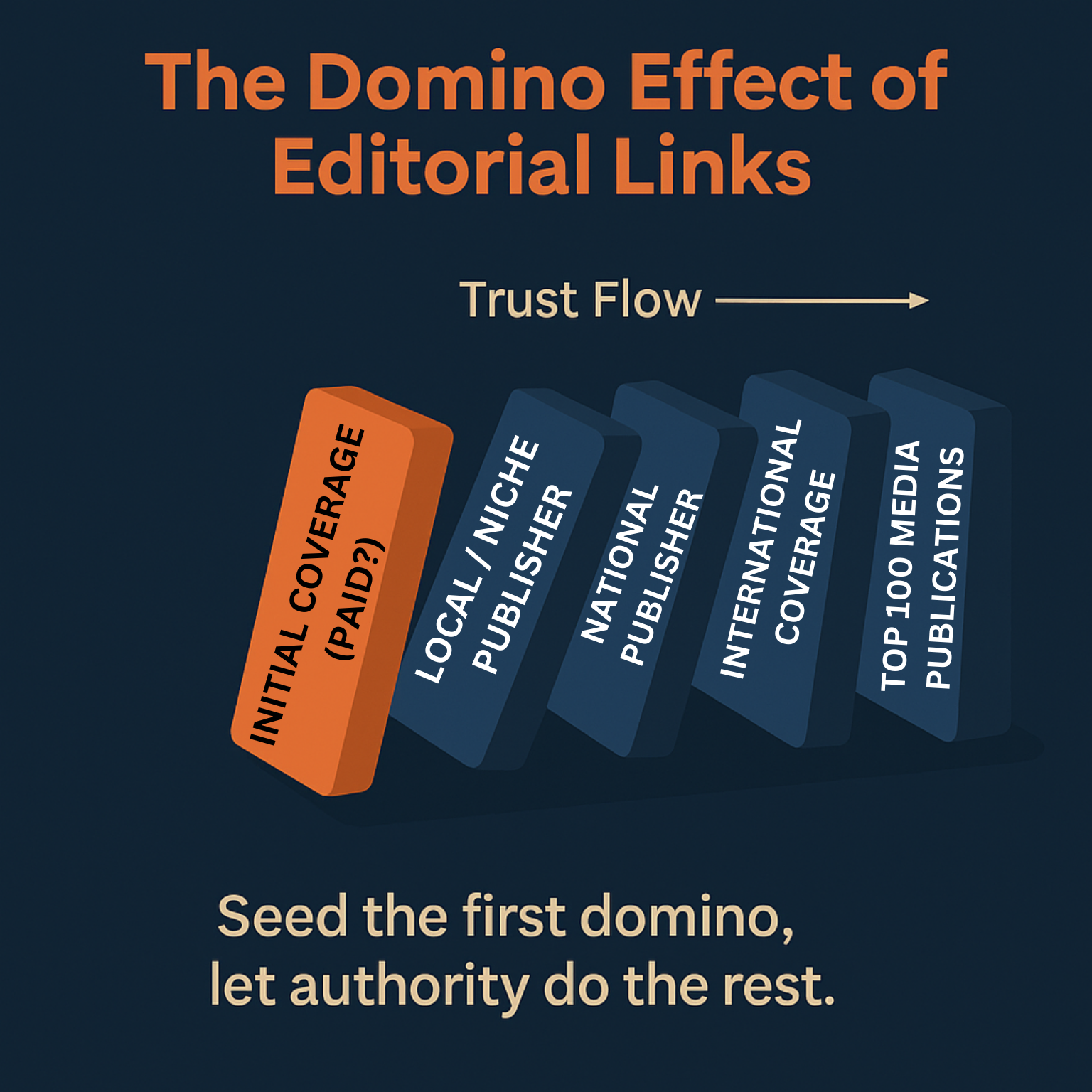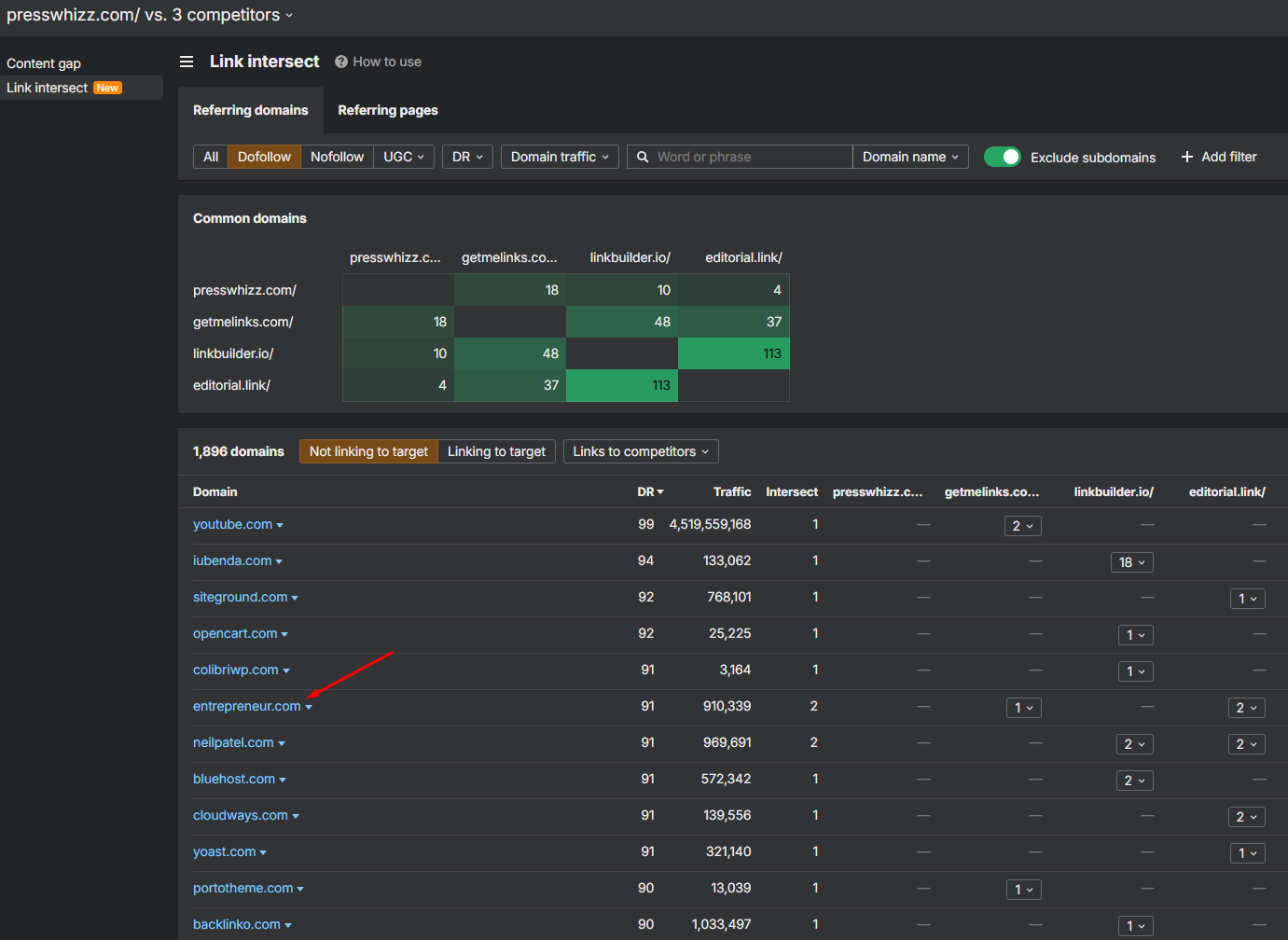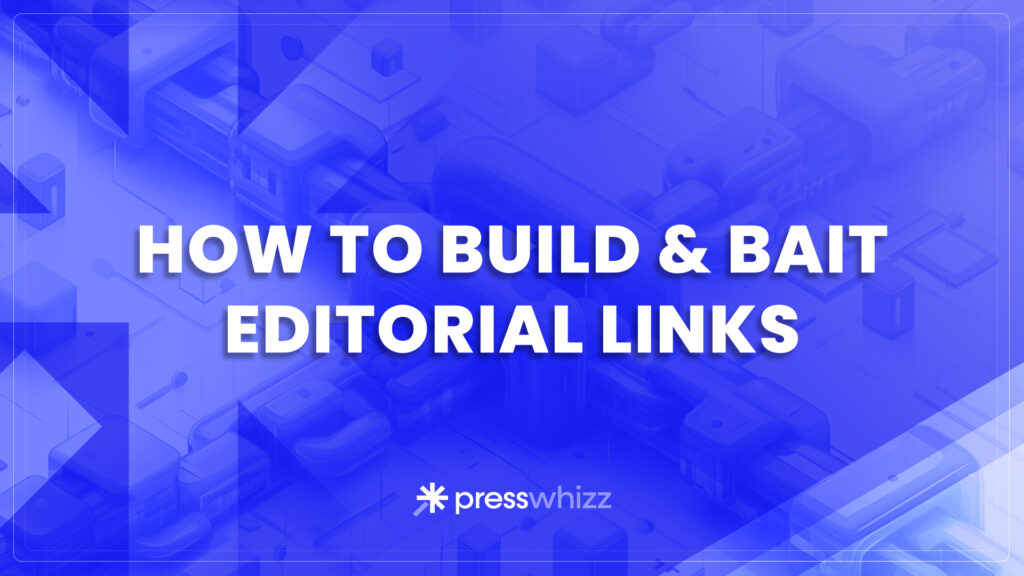There has for a long time been a debate in SEO around what editorial backlinks really are, and that’s because they can appear on sites of all different types, shapes and sizes.
They can come from newspapers, university announcements, industry publications, manufacturers, niche magazines, trade associations, government resources, authority blogs, charities, research papers, and even big aggregators like Wikipedia or Crunchbase.
Most people will associate this as a pure, white hat type of link building technique, but you can also build and scale these links with targeted campaigns as well. And as Google has significantly reduced it’s resources in search, switching off systems and moving it all into AI, it’s easier than ever to use these authority signals to skyrocket your search rankings!
What Are Editorial Links?
Editorial links are natural (or appear natural) backlinks placed by publishers, editors, or journalists because they believe your content adds value to their audience. Unlike paid guest posts or niche edits, they’re not transactional. They’re driven by relevance, authority, and timing.
The three characteristics of an editorial link:
-
Contextual: Placed inside relevant content, not stuffed in a sidebar or footer.
-
Cited as a source: Often supporting a stat, claim, or guide.
-
Trusted domains: Think media outlets, industry blogs, educational resources, or big content hubs.
A great example is this link we organically got from SE Roundtable as part of their daily SEO recap –

Why do they matter, especially in 2025?
-
Google’s leaked docs confirmed contextual links carry heavier weight.
-
Authority stacking is accelerating. Getting linked by an authority domain compounds your own trust signals faster.
-
With AI content saturation, authority signals separate sites that climb from sites that drown.
And aside from your core entity stacking signals, editorial links are usually the closest thing to “update proof” links you’ll ever build.
Editorial Links vs. Traditional Link Building
Traditional link building has always been about control. You pick your anchor, you pick your URL, you pay your way onto a page and whether that’s through a guest post, a sponsored placement, or a quiet little niche edit buried on a blog.
It’s predictable, it’s scalable, but it’s also transparent. Google’s systems have been tuned for years to spot that kind of link pattern, and while they still work, their lifespan is shorter, their impact flatter, and their risk profile higher.
Editorial links sit at the other end of the spectrum. You don’t dictate the placement, the anchor text, or even always the landing page, and you usually don’t want to! The editor, journalist, or site owner makes that call. To Google, that looks organic as hell, because in their eyes, it is.
And that’s exactly why these links carry so much algorithmic weight. They don’t just pass PageRank; they pass trust. They signal that your brand, content, or data was worth referencing without you having to buy your way in.
But here’s the nuance: it’s not really either/or. The smartest SEOs blend both. Editorial links give you the high authority trust layer, the kind of foundation that insulates you from updates and amplifies your trust signals to the next level.
Traditional link building gives you the volume, velocity, and topical depth needed to dominate competitive SERPs. One without the other is incomplete. Chasing JUST guest posts or niche edits leaves you vulnerable to every core update that devalues content for cash links. Relying only on editorial links means slow, inconsistent growth because you can’t always control when or how they land.
The debate isn’t about which is better, it’s about knowing how to use editorial links as your credibility anchor (not to be confused with anchor text) while traditional links fill out the structure. Together, they create the kind of diversified profile that not only ranks, but survives when everyone else drops…
How To Bait Editorial Links at Scale
Nobody is sitting around waiting to hand you these links. You have to create bait. And not just “great content”, because let’s face it, everyone is pumping out 2,500 words of AI fluff and calling it the “ultimate guide.” If you want real editorial pickups, you need to engineer assets that editors, journalists, and industry voices can’t resist referencing.
The first lever is data. Numbers win citations. Proprietary studies, surveys, scraping a dataset, or even reformatting existing stats into something more digestible, these all act like honey pots to journalists. They don’t have the time to run analysis, but they do need credible sources to back up their angles. If you own the dataset, you own the links.
The second lever is controversy and contrarian takes. Playing it safe rarely gets you links. When you publish something that challenges conventional wisdom or puts hard numbers against an industry myth, you create tension, and tension drives attention. Editors love to reference “new findings” or “expert commentary that goes against the norm”, especially on certain publications. If your content makes people argue, it’ll also make them link, I should know!
The third lever is assets editors are too lazy to make themselves, think interactive tools, calculators, unique graphics, maps, timelines, or even meme driven visualizations. These aren’t cheap, but they stick. A well timed interactive tool can generate dozens of pickups across niche blogs and mainstream media alike, without you begging for coverage.
And finally, timing is everything. Newsjacking and launchjacking are criminally underutilized. When a trend, event, or product launch hits, the fastest credible content wins. If you can piggyback your asset into that conversation, whether it’s a quick data visualization, a ranking list, or an authoritative guide, you’ll attract links simply because you were first on the scene.
As a side note, if you’ve ever read “Trust Me, I’m Lying” by Ryan Holiday, then you’ll know you can engineer these stories out of thin air too!
REAL editorial link building at scale is about removing luck from the equation. Instead of waiting to “get noticed,” you architect hooks so strong that when editors, writers, and bloggers are searching for supporting references, they find you and link to you without hesitation...

And sometimes that means bribing the first reference to get the natural ones flowing!
Bait Formats That Work in 2025
In 2025, with AI pumping out more filler than ever, the formats that stand out are the ones that cut through noise, offer instant utility, and give editors exactly what they need: A credible source to reference without doing the hard work themselves.
Let’s start with the most obvious: “original” research and data studies. You don’t need a university lab to pull this off, you just need access to data others don’t have the patience to collect. That might be scraping reviews, analyzing SERPs, surveying your audience, or pulling stats out of APIs. Package it well, throw in a couple of surprising insights, and suddenly your chart is being used in dozens of industry write up, and AI can plug any of your personal skillset holes.
Then there’s visual content designed for lazy journalists. Infographics might sound 2012, but when framed correctly (interactive maps, timelines, or even meme driven visuals that everyone’s grandma shares on FB), they’re still gold. Editors love embedding visuals because it makes their article look more authoritative, and they’ll happily link to you for the source. Pairing AI generated design with your data means you can churn out highly shareable graphics in days instead of months!
Tools and calculators are the next most obvious. Journalists writing about mortgages will cite a free mortgage calculator. Nutrition bloggers will cite a meal planning tool. Finance publications will link to a retirement savings calculator. The utility is the bait. Build once, promote aggressively, and watch links roll in for years.
And remember, don’t underestimate the power of controversial rankings and lists. Everyone hates them, but everyone clicks them, and more importantly, everyone references them. “Top 50 Crypto Influencers Ranked by Engagement” or “The Most Dangerous Cities for Tourists in 2025” will stir up debate, and that debate translates into natural links from blogs, forums, and even mainstream outlets.
All these formats have one thing in common, they are simple: Give editors, bloggers, and journalists something they need but don’t have the time, resources, or creativity to create themselves. Do that consistently, and you stop chasing links, links start chasing you.
The Outreach & Amplification Process
With all that being said though, bait alone doesn’t guarantee pickup. You could publish the most link worthy dataset in your niche, but if no one sees it, you’ve just wasted time and budget. Outreach and amplification is how you take a piece of content from “sitting pretty on your site” to being cited by authority domains within days.
The process starts before you even hit publish. You should already have a hit list of target sites, journalists, and bloggers who’ve linked to similar assets before, and in some cases, be building content for those specific journalists.
Use Ahrefs’ Link Intersect tool or just drop competitor case studies into Site Explorer to see who linked to them. Those sites are your first targets –

Once the bait is live, your first amplification layer is direct outreach. Skip the generic “we thought you’d find this interesting” garbage. Instead, frame the pitch as helping them finish their job.
For example:
-
Journalists: “I noticed you cover [TOPIC]. We just analyzed [X dataset] and found [shocking stat]. Here’s the chart — feel free to use it, full data here.”
-
Bloggers: “I saw your guide on [TOPIC]. Our study on [X] has a chart that would slot perfectly under your section on [Y]. Linking it would help readers with context.”
Make the link placement feel inevitable.
The second amplification layer is paid social seeding. This is where 99% of SEOs are lazy. Throw $100 behind a LinkedIn or Twitter/X ad targeting journalists, editors, and influencers in your vertical. You’re not trying to drive conversions, you’re just forcing the right eyeballs onto your bait. The beauty? Journalists rarely ignore a stat-driven asset if it’s shoved into their feed.
The third layer is syndication. Repurpose your bait into press releases, LinkedIn posts, Medium summaries, and even Reddit threads. Each acts as a secondary hook that both drives traffic and signals “this content is being discussed.” Reddit in particular is lethal if you post in the right subreddit, journalists scrape it for ideas constantly.
Finally, you need follow ups setup. You should have:
-
Day 1: “Here’s the resource.”
-
Day 4: “Did you get a chance to review? Here’s the chart embedded.”
-
Day 9: “Saw you covered [related topic], just looping this in again.”
Polite persistence beats spamming. Think of it as account based marketing, but for link building.
The amplification process is about manufacturing inevitability. By the time you’re done, an editor covering your niche should have seen your asset three different ways, in their inbox, in their feed, and referenced by peers. At that point, linking isn’t just natural, it’s unavoidable.
Scaling Outreach With AI & Automation
Manual outreach works when you’re testing bait formats or working small campaigns. But when you’re serious about pulling in dozens, even hundreds of editorial links per month, you can’t rely on hand-crafted emails and spreadsheets. That’s where automation and AI come in, not to replace the human touch, but to amplify it.
The first step is prospect harvesting at scale. Tools like Ahrefs, SEMrush, or even niche scrapers will surface who’s linking to similar assets in your space. Traditionally you’d export these lists and spend hours cleaning them. Now you can pipe those exports directly into Google Sheets or Airtable, where AI prompts (via OpenAI API or Claude) automatically categorise them: journalist, blogger, niche site, aggregator. This saves hours of admin and means your targeting is laser-focused
The second step is personalisation at speed. One of the biggest myths in outreach is that you need to write every email from scratch. What you actually need is the illusion of bespoke messaging. Using AI, you can feed in a journalist’s last 3-5 articles, auto-summarise them, and generate a one-liner opener that references their work. Drop that into your email template, and suddenly you’ve gone from “generic blast” to “looks like you did your homework.”
Then comes automation sequencing. With tools like Make.com or Zapier, you can build flows that look like this:
-
Prospect added to Airtable → AI generates subject line + opener → Gmass sends wave 1 email.
-
No response after 3 days → AI re-writes opener → wave 2 email sent automatically.
-
Still no response → push to LinkedIn DM task for manual follow-up.
You’re automating the grunt work while keeping escalation steps human, so you never look like a spam bot.
And finally, we need real time monitoring. Editorial opportunities are time sensitive, journalists want data now, not next week. You can set up Google Alerts, TweetDeck/X keyword searches, and HARO/Help A B2B Writer feeds to pipe directly into Slack or email. Layer AI summarization on top so you don’t waste time scanning noise. When a relevant request drops, you’re first in the inbox with your baited asset.
This is how you scale without burning your list or burning out your team: automate the sourcing, accelerate the personalisation, and systemise the followups. Done right, it looks less like “outreach” and more like an invisible, always on editorial placement machine.
Reverse Engineering & Greasing the Wheels
All the white hat theory in the world is nice for conferences and corporate decks, but when it comes to ranking in the real SERPs, a lot of niches make it very difficult to build these types of links for, and some will 100% require payment every time. So before I end this blog post, lets strip away the idealism and leans into tactics that actually move the needle when time and competition are stacked against you.
Here’s my 4 step money hat version:
1. Reverse Engineer Competitors
-
Drop their domains into Ahrefs, Majestic, or PressWhizz’s FREE “Existing Links” & “Search by Keywords” Tools.
-
Export every editorial style placement (news, industry blogs, .gov/.edu citations, mentions in roundups).
-
Tag the journalists/editors by name and publication and build your prospecting list off their wins.
-
Replicate or outdo their bait angle, then go after the exact same targets with a stronger pitch.
2. Pay for Initial Placements
-
Identify small-to-mid-tier blogs, trade publications, or micro-news outlets that sell “editorial coverage.”
-
Seed your campaign with 2–3 of these links to make your dataset/tool look legit.
-
Negotiate bundled pricing or swaps to keep costs low but impact high.
-
Use those first placements as social proof when pitching bigger publications (“already covered by X and Y”).
3. Bribe & Incentivize Journalists/Editors
-
Cash still works! An envelope under the table or “sponsorship” invoices can work, but they can also get your brand blacklisted.
-
Non-cash bribes work better: Exclusive access, co-branding, or letting them “break” your story.
-
Some will play ball for affiliate overrides or lead-sharing deals, use economics over flattery.
-
Keep it subtle: You don’t need a contract, you need plausible deniability.
4. Launder & Amplify Links
-
Buy/bribe into tangential editorial mentions that aren’t directly about your money page.
-
Push authority through tiered links (PBNs, edits, social stacking) into those safe “seed” mentions.
-
Redirect authority back to your key assets with clever internal linking or soft 301s.
-
To Google, it looks like a trusted editorial source is backing you — not a hustler stacking signals.
It’s that easy: Spy → seed → sweeten → launder.
My Final Thoughts
Editorial link building is what separates the amateurs from the real, creative link builders. Anyone can buy a guest post on some recycled blog network, but when you can consistently bait and win links from publications that editors, journalists, and even Google itself can’t ignore, that’s when you’ve stepped into authority mode and have a very profitable skillset that can transcend niches.
The debate around what editorial backlinks really are will keep going, but the truth is simple: they’re trust multipliers. They’re the links that survive algorithm updates, that compound your entity signals, that make the difference between being a disposable affiliate project and a brand that actually carries weight in its niche.
The mistake most SEOs make is treating them as “bonus links” — something nice to have on top of guest posts and edits. That’s backwards. Editorials should be the backbone, the anchor that props up your whole link profile. Traditional tactics can and should be layered in on top for velocity and volume, but without authority signals from trusted sites, you’re building on sand.
The beauty of 2025 is that the game has never been easier to hack. With AI automating the boring parts of outreach, with datasets and scraping tools at our fingertips, and with Google’s own resources stretched thin, manufacturing editorial hooks is more scalable than ever. You don’t need to be The New York Times to get cited by The New York Times. You just need to produce something their writers can’t produce themselves, and push it under their noses at the right time.
If you take nothing else away from this guide, take this: editorial links aren’t about luck, they’re about engineering inevitability. Build bait that solves a problem for editors, amplify it until it’s unavoidable, and layer it into a diversified link strategy. Do that, and you won’t just climb the SERPs — you’ll stay there when everyone else gets wiped out.

